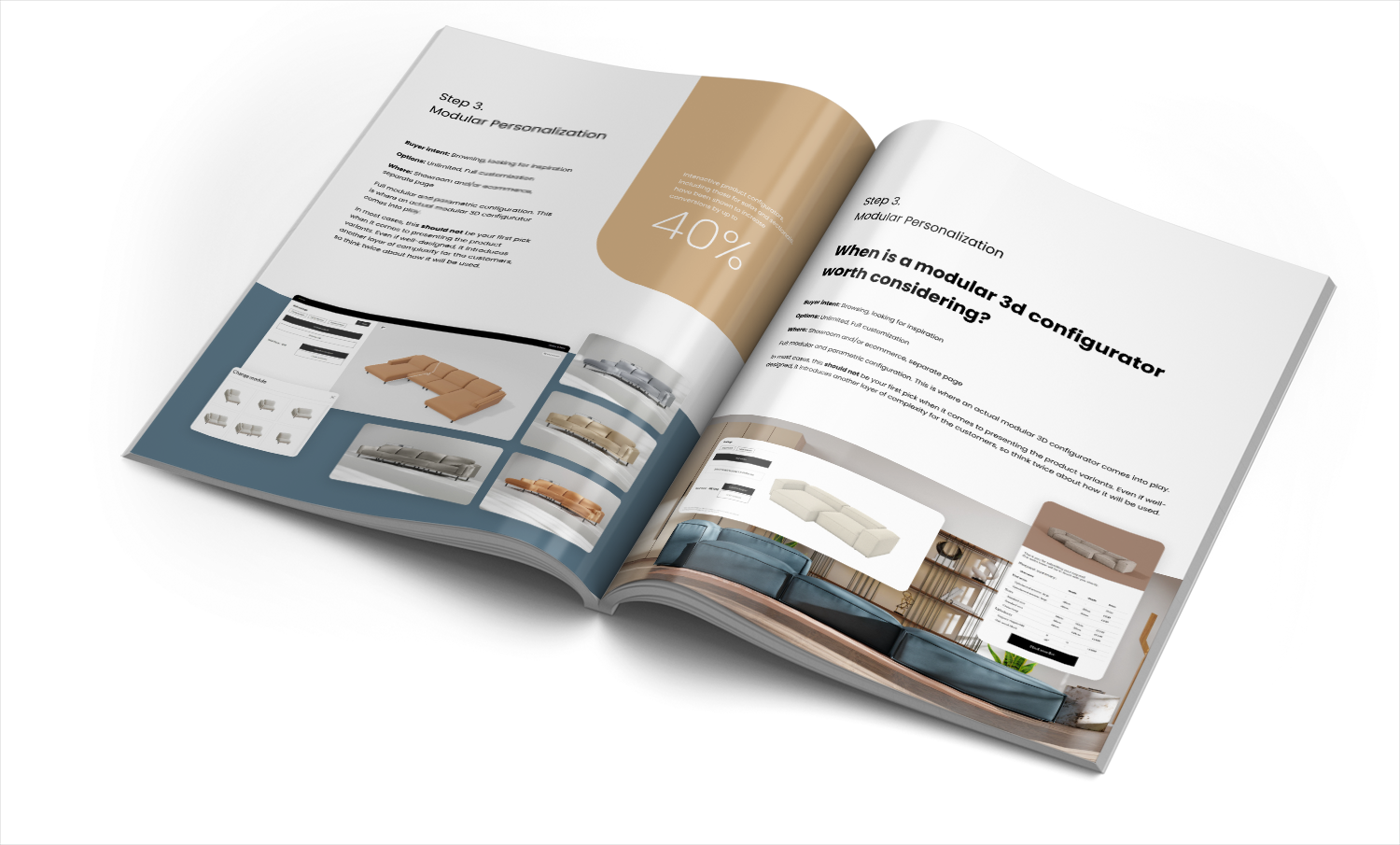The Ultimate 2025 Sofa Configuration Guide
Get your free copy todayy!

For many B2B furniture makers, moving into B2C furniture feels like switching from chess to poker. In B2B, success comes from logic, specs, and precise configurations. But when the buyer is a homeowner, logic takes a back seat. People don’t buy a SKU - they buy a vision of how their life could look. And that vision is painted by emotion, mood, and story.
I’ve seen manufacturers struggle with this shift. They come from a world where deals are made on spreadsheets and purchase orders. When they move to B2C, they realize customers don’t care about the part numbers. They care about how it feels to sit on that sofa on a Sunday morning, or how a dining table fits into their family’s rituals. That’s the real product they’re buying.
The big mindset change is that personalization and visualization aren’t tech tools - they’re expressions of brand values. If your brand stands for individuality or craftsmanship, that spirit needs to live in every touchpoint, not just in a hidden 'Configurator' tab.
B2B companies often carry their business logic straight into their B2C websites. The result is usually too functional, too technical, and too product-centric. The focus is on dimensions, specs, and price - while the consumer is still dreaming.
When I walk through these sites, I often see misplaced effort. Tons of variations, options, dropdowns. The belief is: the more options, the better. In reality, that’s paralysis. In B2C furniture, more isn’t more - clarity is. The buyer wants reassurance, not a spreadsheet of possibilities.
Personalization, then, should emerge from a strong branding strategy. Instead of showing every possible fabric, show three interiors with distinct moods. Invite the customer to identify with one. That choice sets the foundation for emotional connection - and only then should detailed customization be introduced.
Most guides say “offer powerful configurators early.” But in practice, that’s exactly when customers drop out. They’re not ready yet. They’re exploring who they are, not what they want.
Here’s the hard truth: personalization isn’t about a configurator. It’s about identity. In successful B2C furniture brands, personalization is baked into the brand story, not attached as a tool.
Imagine your website like a conversation. The pages, visuals, and product gallery all speak in the same voice. If your ‘core value’ is living well in small spaces, everything - from AR previews to product imagery - should whisper that message. This is where visual presentation and customization meet.
A great example comes from our Modern Shelving case study. This brand understood that product presentation wasn’t about showing endless modular options. It was about showing how those options fit into real, recognizable lifestyles. Their use of interactive visuals and AR helped customers picture themselves in the scene. That emotional leap is everything.
Another useful framework is the one described in The 3 Levels of Product Personalization and How to Use Them. It divides personalization into inspirational, selectable, and configurable levels. Most B2B brands jump to the last one - configurators - without first building the story. But B2C customers need the earlier levels to form trust and desire.
You can also explore how visual materials differ depending on their role in the journey. In our resource, Difference Between 3D Configurator and Variant Visuals, we show how curated variant visuals on the product page can anchor clarity and invite curiosity, before leading to a deeper customization path.
The modern customer journey stages for B2C furniture are not linear - they loop, bounce, and repeat. Still, most experiences follow four emotional beats: inspiration, exploration, consideration, and decision.
1. Inspiration
This is the “dreaming” phase. High-quality imagery, brand storytelling, and curated lifestyle scenes matter most. The goal isn’t to sell yet - it’s to be remembered.
2. Exploration
Customers start refining taste. This is the right moment to introduce clear product categories, variant visuals, and AR visualizations. According to Cylindo: UX Best Practices from Seven Leading B2B Furniture Businesses, visuals and AR tools significantly improve emotional engagement at this stage.
3. Consideration
They want to validate desires with facts. Here, swatch packs, 3D viewers, and saved configurations help bridge the online and offline gap. When a customer can hold a fabric sample that matches her saved online visualization, trust multiplies.
4. Decision
This is where personalization becomes real. The configurator now delivers precision, not confusion. The rep can assist via a shared interface, quoting the exact variant the buyer visualized earlier. This unified experience across augmented reality tools, e-commerce, and in-store consultation transforms curiosity into confidence.
The point isn’t to show millions of variants. It’s to help the buyer find their right one. That’s when personalization feels empowering, not overwhelming.
Many furniture brands trip at the same spots. They build a technical configurator before defining their emotional promise. Or they design stunning visuals that don’t connect to showroom reality. Or worse - they treat personalization as a checkbox feature instead of a guiding principle.
Trust me, I’ve seen it all. When shifting to B2C, you can’t separate technology from story. They must move together. One strengthens the other.
To summarize, successful B2C furniture marketing counts on:
When emotional consistency replaces product complexity, something interesting happens. Customers stop comparing specs - they start imagining themselves living your story. And that’s when they decide to buy.
If you’re serious about moving from B2B logic to B2C storytelling, start with introspection. Ask: what life vision are we really selling? Once that’s clear, every visual, tool, and interaction falls into place.